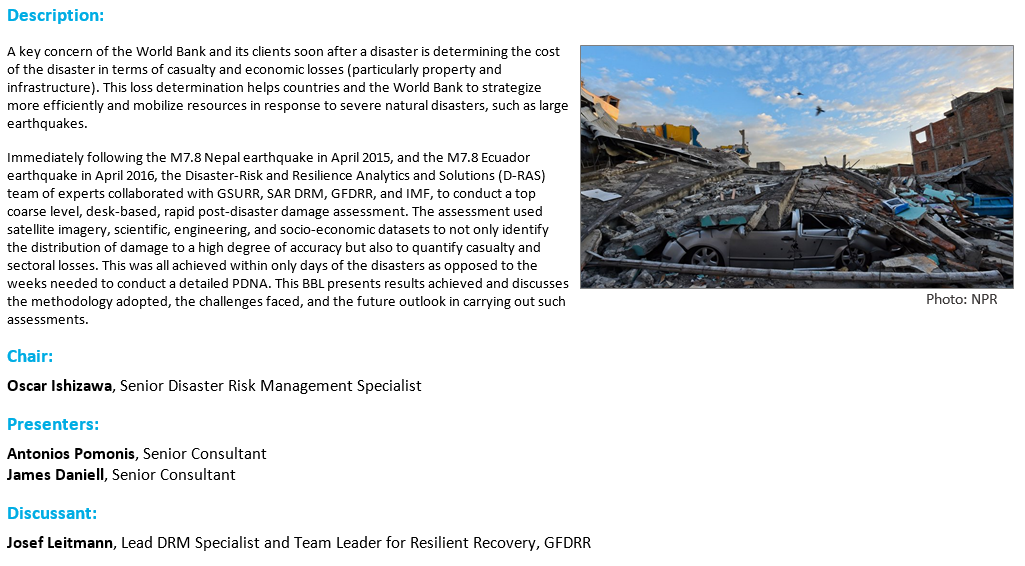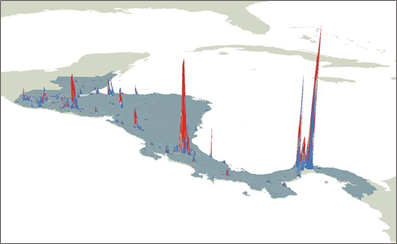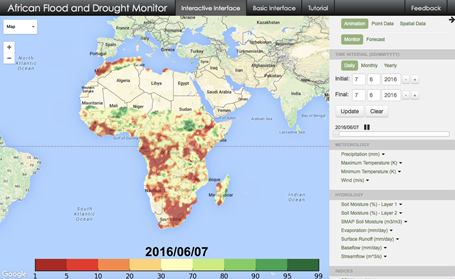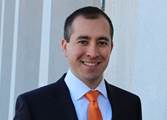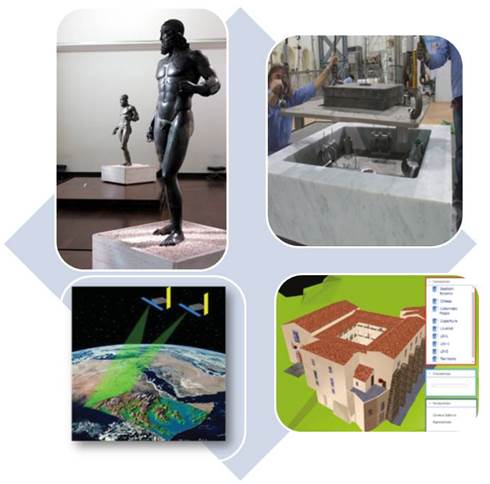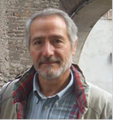

| Member | Action | Date | ||||
|---|---|---|---|---|---|---|
|
|
Updated BBL Urban-Rural Spatial Patterns Revisited The iUrban Model on calendar Show more |
Jun 04 2018, 7:26 PM |
||||
|
|
Updated BBL Responding to Disasters A new method for rapid post disaster damage assessment on calendar Show more |
Jun 04 2018, 7:26 PM |
||||
|
|
Updated BBL - Spatial Disaggregation of Gross Domestic Product An Innovative Method for Producing High Resolution Economic Activity Maps for Disaster Risk Management on calendar
|
Jun 04 2018, 7:26 PM |
||||
|
|
Updated BBL Princeton’s Flood and Drought Monitors for Africa and Latin America and the Caribbean on calendar
The Disaster Risk & Resilience Analytics and Solutions (D-RAS) KSB presents
Princeton’s Flood and Drought Monitors
for Africa and Latin America and the Caribbean
Wednesday, June 15, 2016 | 12:30 – 2:00 PM | Room I 6-170
Click for RSVP and add to calendar Join Via WebEx
Droughts can have serious impacts on agriculture (particularly in developing countries with little irrigation capacity), electricity generation, water resources for domestic consumption, and ecosystems health. These can lead to severe famines, loss of lives, and mass migration. Floods, can also cause loss of lives, damage to infrastructure, and increase the risk of water-borne diseases. Thus, understanding current hydrometeorological conditions and being able to forecast these extremes with as much lead time as possible is critical for stakeholders to be able to able to prepare and act. However, developing countries often have poor climatic services due to lack of infrastructure (including a lack of monitoring hydrometeorological stations), technical expertise, and investments. With the help of satellites, and climate and hydrological models, however, we have been able to expand our study of droughts and floods to these regions. The Terrestrial Hydrology Research Group at Princeton University has developed the Flood and Drought Monitors for Africa and Latin America and the Caribbean (http://stream.princeton.edu), which include monitoring of current conditions, forecasts up to three months, as well as data records back to 1948. This last characteristic is another important feature, given that users can easily access and download the Monitors’ data, allowing them to carry out further analysis.
Chair:
Niels B. Holm-Nielsen, Lead Disaster Risk Management Specialist, GSURR
Presenter:
Julio Herrera-Estrada, Land Surface Hydrology Research Group, Princeton University
Discussant:
Abigail Baca, Infrastructure Specialist, GSURR
Please find attached the presentation. Thanks! |
Jun 04 2018, 7:26 PM |
||||
|
|
Updated The Economic Silver Lining to the Human Catastrophe of a Natural Disaster on calendar Show more |
Jun 04 2018, 7:26 PM |
||||
|
|
Updated Enhancing Resilience of Cultural Heritage Saving Unique Treasures, Contributing to Local Economies on calendar
Brought to you by the Disaster Risk Management Analytics and Solutions (D-RAS) KSB &
Enhancing Resilience of Cultural Heritage Saving Unique Treasures, Contributing to Local Economies Wednesday, December 2, 2015 || 12:30 - 2:00 pm || Room I 7-022
How do we enhance resilience of delicate cultural heritage assets that attract visitors to the cities we work with? This BBL will present some innovative and compelling solutions applied to heritage in urban areas prone to natural disasters. A team of experts from the Italian National Institute of Geophysics and Volcanology (INGV), University of Calabria, and Italian National Agency for New Technologies (ENEA) will give us the unique opportunity of learning about their groundbreaking solutions and their implications for local economies.
Solution 1: Anti-Seismic Basements. This solution is about a state-of-the-art device to reduce vulnerability of heritage artefacts to seismic hazards, designed to absorb vibrations and shocks. The cases of the Riace Bronzes and Michelangelo’s David will be presented. These statues are kept in highly seismic urban areas and are prime assets to attract visitors to the cities in which they are located.
Solution 2: Space Observation and 3D Web. An application of advanced monitoring of cultural heritage will be presented. Building on know-how developed for space observation, blended with 3D modelling, this solution is the result of a multiyear project called Massimo and aims at putting in place a monitoring system that integrates real time and remote sensing data (proximal, airborne, and satellites) with the objective of making heritage sites safer for visitors.
Chair: Catalina Marulanda, Lead Urban Specialist and Acting Practice Manager, GSURR
Presenters:
His research fields include earthquake protection of heritage assets, analysis of movable and semi-movable heritage assets, dynamic characterization and experimental verification of new technologies and materials for seismic protection of delicate instruments and control systems for strategic infrastructures and heritage, design of anti-seismic basements for high vulnerable statues, structural dynamics, shaking table tests, combined climatic and vibration tests, EMC tests, qualification of systems and components for industrial applications, railway transport, aerospace, and civil engineering.
|
Jun 04 2018, 7:26 PM |
||||
|
|
Updated Strengthening of Historic Buildings Increasing Resilience or Losing Value on calendar
The KSBs on Disaster Risk Management Analytics and Solutions (D-RAS) & Culture, Heritage, and Sustainable Development present:
Strengthening of Historic Buildings: Increasing Resilience or Losing Value Wednesday, November 11, 2015 || 12:30 - 2:00 pm || Room I 2-220
In the aftermath of a natural disaster such as an earthquake, governments often find they do not have adequate technical, legal, or financial tools needed to implement a robust reconstruction program. More than this, they may even lack the necessary knowledge. This is particularly true of cultural assets such as historical buildings. For TTLs and other stakeholders, it also raises important questions such as:
Thirty years after the recommendations for repairing and strengthening historic buildings were presented at International Council of Monuments and Sites (ICOMOS) General Assembly, this timely BBL evaluates the approach to "reconstruction" of historic buildings with reference to recent destructive seismic events worldwide, where historic buildings have been seriously affected. Specifically the BBL addresses:
We invite you to join us to find these answers that also have direct implications for the Building Back Better approach undertaken by the Disaster Risk Management (DRM) community and the World Bank, and more broadly, for cultural tourism and the empowerment of local communities.
Chair: Catalina Marulanda, Lead Urban Specialist and Acting Practice Manager, GSURR
Presenter:
Discussant: Ahmed Eiweida, Lead Urban Specialist, GSURR
Dina is an EERI member, a SECED member and a member of the EEFIT team. She is associate editor of the Bulletin of Earthquake Engineering, and member of the editorial board of the International Journal for Architectural Heritage. She has been a consultant to the WB, IDA, UNDP and UNESCO on projects of heritage conservation and hazard protection in the Middle East, Ethiopia, Turkey, Iraq, Nepal etc. |
Jun 04 2018, 7:26 PM |
||||
|
|
Updated Country Disaster Risk Profile: Belize on Documents
Hurricane and Earthquake risk profile for Belize. |
Jun 04 2018, 7:26 PM |
||||
|
|
Updated Country Disaster Risk Profile: Jamaica on Documents
Hurricane and Earthquake risk profile for Jamaica |
Jun 04 2018, 7:26 PM |
||||
|
|
Updated Country Disaster Risk Profile: Saint Lucia on Documents
|
Jun 04 2018, 7:26 PM |
||||

